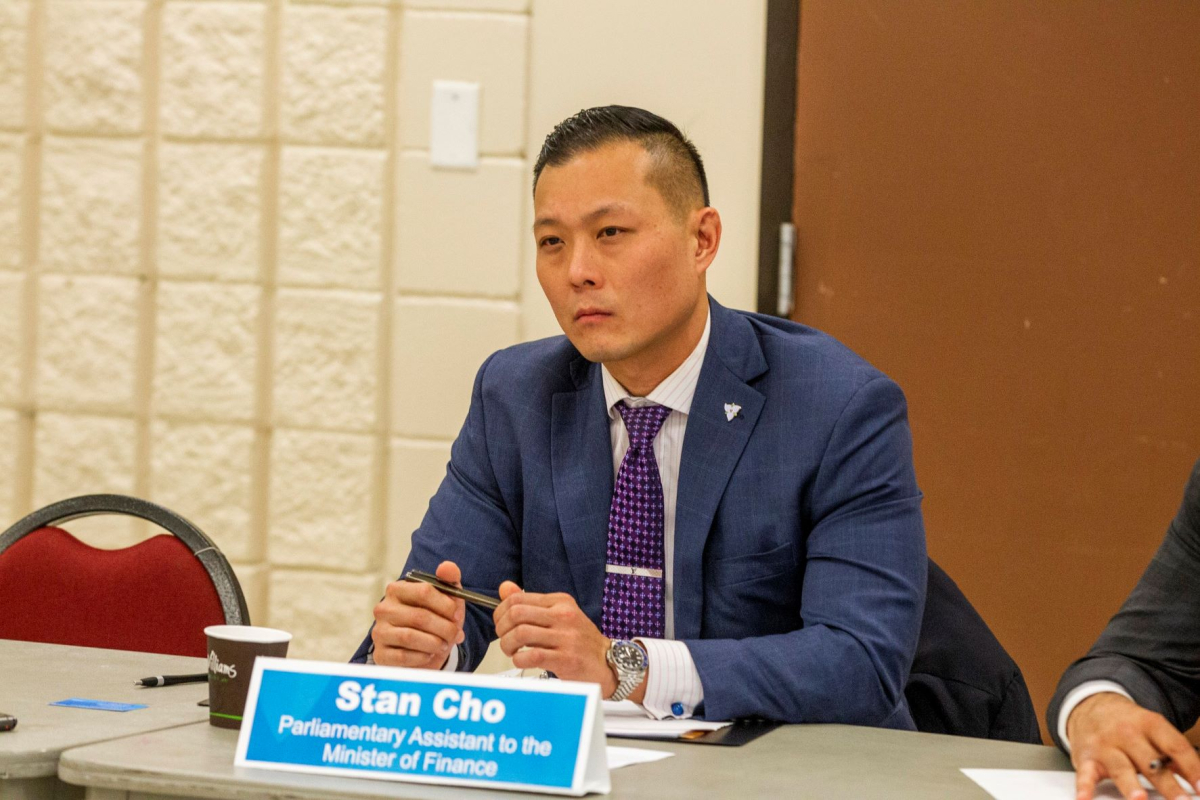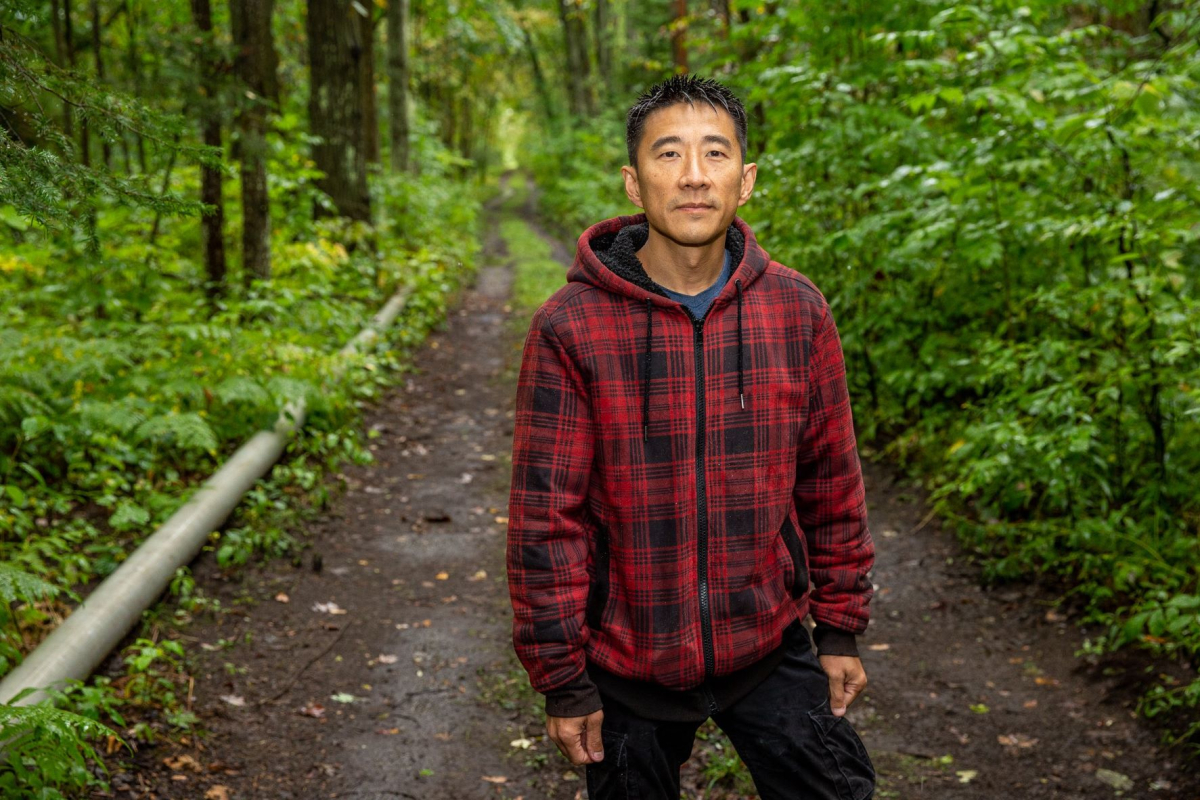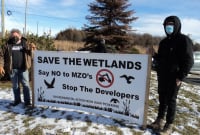Support strong Canadian climate journalism for 2025
It was a slight route change, almost imperceptible on a map.
But with it, a controversial planned highway would cut through homes tucked away in a dense forest north of Toronto — instead of slicing across the edge of a golf course.
When Ministry of Transportation staff revealed a proposal in April for the Bradford Bypass’s new route, the government said it would lessen the 16.2-kilometre road’s impact to the Holland River and avoid an archeological site.
It did not mention that the golf course being spared is co-owned by the father of Progressive Conservative MPP Stan Cho, who in June became the associate minister of transportation.

The ministry’s public silence on the golf course’s connection to Cho is part of a broader pattern of secrecy in the government’s fast-tracking of the bypass, which would run through York Region and Simcoe County, connecting highways 400 and 404, a Canada’s National Observer and Torstar investigation has found.
Cho’s office says the MPP declared a conflict of interest upon his appointment, with a protocol in place blocking his access to information related to the bypass.
In their rush to resurrect the once-shelved highway, Premier Doug Ford’s Progressive Conservatives are forging ahead without divulging basic information about the project. In the void, there are mounting questions about the highway’s environmental impact and who stands to benefit from its construction.
If built, its four lanes would cut through 27 waterways, nearly 11 hectares of sensitive wetlands and the Holland Marsh, a region of the protected Greenbelt nicknamed “Ontario’s vegetable patch” for its fertile soil.
Even though the most recent environmental assessment for the project is nearly 25 years old, the Ford government has moved to fast-track it before completing another review. Construction of a new bridge and interchange can begin any time.

The government’s plans for the highway have yet to be completed. Internal records, never before made public, show the province was building a business case to make it a toll highway. The documents also show the Ministry of Transportation has quietly identified alternative options that it hasn’t discussed publicly — some of which could deliver comparable benefits with less impact on the environment.
Meanwhile, large developers, many of them prolific political donors, collectively own at least 3,100 acres of prime real estate near the proposed route and stand to benefit if the highway is built.
Five of the developers have close ties to Premier Ford’s government through insiders and former party officials now acting as lobbyists. One of those lobbyists was the chair of Transportation Minister Caroline Mulroney’s 2018 PC leadership campaign.

The idea to build a corridor connecting highways 400 and 404 has been around since the late 1970s.
The PC government of the day signed off on the project’s environmental assessment in 2002, with construction to begin within four years. But Liberal Premier Dalton McGuinty, who won the 2003 election on promises to focus on public transit, shelved it.
Under pressure from municipalities who wanted it built, the Kathleen Wynne Liberals put the bypass back in its long-term plans in 2017.
The project lay dormant until 2019 when Doug Ford’s Progressive Conservatives announced a plan to put shovels in the ground.
The studies the environmental assessment was based on were completed in 1997. That year, Princess Diana died. The Spice Girls released their hit album "Spiceworld."
Policies protecting the climate, Greenbelt and Lake Simcoe had not yet been written.
The now-dated assessment that was based on those 1997 studies warned the highway could contaminate groundwater and the Lake Simcoe watershed, and pollute the air more than is recommended by current air standards. It also noted that the Chippewas of Georgina Island First Nation, located on Lake Simcoe, had opposed the bypass over concerns about archeological sites in the area. (Officials at the nation declined an interview on the subject.)
Since the bypass was last studied, Ontario has added more than two million vehicles to its roads. A growing body of evidence shows building more highways doesn’t fix clogged traffic — instead, they attract more vehicles, a concept called induced demand. If you build them, drivers will come.
A spokesperson for Mulroney’s office said the bypass is needed to tackle traffic congestion that is forecast to worsen over decades as the region’s population grows, and that internal modelling shows the highway would contribute to a 0.3 per cent increase in area traffic. The government’s plans balance its responsibility to safeguard the environment with the need to build new infrastructure, she said.
The spokesperson, Natasha Tremblay, also noted that the ministry is studying, among other things, impacts on groundwater and stormwater management, but critics say there will be no meaningful public scrutiny of the project’s environmental impact. That is because the government has exempted the project from the Environmental Assessment Act.
“Congestion already costs Ontario billions of dollars in lost productivity, adds to the costs of goods and actually increases carbon emissions,” Tremblay said. She also said the highway could save drivers up to 35 minutes.
Mulroney has said construction of the bypass would cost about $800 million. The Toronto Region Board of Trade estimates the project would cost nearly twice that, with a projected price tag of $1.5 billion.
The new highway could see more than 30,000 vehicles per day on average streaming through what was once one of the largest wetlands in southern Ontario. Settlers drained nearly two-thirds of the Holland Marsh in the 1920s to use its rich soil. Today, farms there produce about $50 million per year of onions, carrots and other crops. The bypass would avoid the agricultural area.
It would instead pass through some of the marsh’s remaining wetlands, deemed by a previous government to be “provincially significant,” a title given to places Ontario officials find most precious. Road salt could wash into the Holland River.
“Everything flows north,” said Victor Doyle, a former provincial planner credited as one of the architects of the Greenbelt. “So all the contaminants, the oil, the gas, whatever’s dripping off cars, the salt in the winter, is all going to go north into Lake Simcoe.”
Locals have strongly supported the bypass proposal for decades.
In Bradford West Gwillimbury, one of the two main municipalities the bypass would run through, Mayor Rob Keffer said the project is an “absolutely essential piece of infrastructure.” The Holland Marsh Growers' Association has said the road would help move farmers’ goods to market.
In the other municipality, East Gwillimbury, Coun. Loralea Carruthers said the proposed bypass would help address the traffic congestion and future commuting needs in the town where the population is expected to almost quadruple by 2051.
Carruthers also noted the “added value” of the government’s commitment to a $40-million trail system to be developed alongside the bypass to expand the trail network in the area.
Richard Wyszatko, owner of Albert’s Marina in the bypass area, says the project would provide long-term benefit to the community where “there is no good or decent road.”

Further north of the proposed route, however, there are rumbles of discontent. Local governments debate the environmental cost of the highway and worry if they have enough information to lend it their support. This year, councils in Barrie, Innisfil and Georgina have declined to pass motions supporting the province’s move to fast-track the highway, a marked difference from their years of unequivocal support.
Current Ontario Liberal Leader Steven Del Duca, who was Wynne’s minister of transportation in 2017 when the Liberal government of the day revived the proposed bypass, declined an interview about the investigation’s findings. Speaking to the Star at Queen’s Park earlier this month, Del Duca said local support for the project means it merits consideration.
Ontario NDP Leader Andrea Horwath said she was troubled by the findings of the Torstar/Observer investigation.
“Ford’s developer friends are the ones that get what they want, and it’s going to cost the rest of us and destroy the environment,” she said.

In 2017, a pair of investors bought the Silver Lakes golf course, nestled along a branch of the Holland River in East Gwillimbury.
The buyers were Kenneth Yoo and John Cho, father of Progressive Conservative MPP Stan Cho.
Shortly after the purchase, they were quoted in a Korean daily newspaper calling the golf course a “future-looking investment.”
“It is currently tied to a Greenbelt, but it can be transformed into a residential area. In that case, the value will rise beyond imagination,” Yoo is quoted as saying in Korean. The golf course declined to comment for this story.
For now, Silver Lakes is a popular destination for Korean golfers, with an 18-hole course and a banquet hall that seats 200.
The province’s proposed route originally sliced through the second, third and 11th holes. In April, the Ministry of Transportation released a proposal for a revised plan, one that avoids the golf course and instead runs through residential properties.

John Cho’s son, first elected to the Ontario Legislature as MPP for Willowdale in 2018, was tapped to be Mulroney’s associate minister a couple months after the government revealed the proposed route change. He declared a conflict of interest when he was elevated to this cabinet role in June, said Bradley Metlin, a spokesperson for Cho’s office.
“Minister Cho has not participated in any conversations regarding the Bradford Bypass,” Metlin said in an email.
East Gwillimbury resident Bill Foster said his concerns about the government’s evaluation of the route change were not eased by Cho’s declaration of a conflict of interest.
“Frankly, I think it’s a joke,” Foster said, adding that he worries others in the government could still work in Cho’s favour.

Foster, who fought the bypass in the '90s as the founder of a group called Forbid Roads Over Green Spaces (FROGS), stands among a growing number of locals and environmental groups raising concerns about the project’s impacts and the lack of information available to the public.
“(The government has) kept it a secret. No one knows what’s happening around here,” Foster said,
Never-before-made-public documents show the government has actively considered making it a toll road. Mulroney has dodged questions publicly about whether it’s in the province’s plans, but records obtained through FOI by the Simcoe County Greenbelt Coalition and provided to Torstar and Canada's National Observer, show the government recently prepared a business case for tolling.
“I’m hoping to model toll rate scenarios for the Bradford Bypass (e.g. one option is to use 407E rates) to see opportunities to recover capital costs for currently unfunded projects,” an MTO staffer wrote in an Oct. 28, 2020 email to two ministry traffic planning experts.
“Our timelines are very tight so (I) wanted to get a sense of (how) quickly this can be pulled together.”
An April 14 email between MTO staff contemplated one scenario that included a toll rate as much as 60 per cent higher than the 407’s. In another email chain, government-hired consultants noted that tolling the bypass could increase collisions on nearby roads, which could see an influx of drivers avoiding paying for the highway.
Mulroney’s office initially said it hadn’t made a final decision about tolling. But after questions from Torstar and the Observer about the FOI documents, it said the ministry had considered all financing options for the bypass, but “it is not our intention to toll this highway.”
Avia Eek, a King Township councillor who supports the bypass, opposes tolling it. “I guess they want to recoup as much revenue as they’re possibly able to. But I think in the long term, that may defeat the purpose because then (commuters and truckers) are not going to use it unless they absolutely have to if it’s a toll,” she said.
Another internal document reveals the highway’s primary purpose — reducing congestion — could be achieved by not building it at all.
A 2014 government-commissioned report examining transportation needs near Lake Simcoe gave high marks to the planned bypass for how easy it would be to build. The report, obtained through FOI and provided to this investigation by Ecojustice, noted the highway would be heavily used and that its planned four lanes might have to be widened to six by 2041.
The highway also received the lowest possible score for environmental impact. Improving interchanges, adding specialized trucking lanes on some existing roads and creating HOV lanes on Hwy. 400 could deliver similar benefits with a lesser impact, the report found.
In response to the Torstar/Observer findings, Ontario Green Party Leader Mike Schreiner called for the government to put options from the 2014 report back on the table.
“I think there are transportation needs in the region that need to be addressed, but we need to address them in the most fiscally and environmentally responsible way,” he said.
The province chose to route the highway through some of the Holland Marsh’s narrowest sections to minimize its environmental impact, said Tremblay from Mulroney’s office. The bypass will cross just 0.35 per cent of the Holland Marsh’s provincially significant wetlands, she added.
Margaret Prophet, executive director of Simcoe County Greenbelt Coalition, said the government is trying to “obfuscate” the significance of the impact on one of the most important wetlands in Ontario.

“This part of the marsh that they’re crossing may only be a small fraction of the wetland, but that is not including the downstream impacts,” Prophet said.
The Holland Marsh is the largest and most important wetland in the Lake Simcoe watershed, which provides drinking water to seven towns and communities.
While this spring the federal government stepped in to do its own environmental assessment of Ford’s other proposed highway — the 413 — it declined to do a similar review of the Bradford Bypass.
Gerda Wekerle, an environmental studies professor at York University, said the Ontario government appears to be moving forward with the project “extremely quickly.”
“The question is why now?” Wekerle said. “We have one year to go to an election in the province and it may change to another party... So there’s an incentive for them to try to court and assuage their large donors.”
In recent weeks, Ford and his ministers have laid the bypass and the 413 as cornerstones of their re-election strategy, fortified by a multimillion-dollar ad blitz to make their case to voters.
“While the Liberals and NDP constantly fight our infrastructure projects that reduce gridlock and get Ontarians to where they need to be, we are the party that gets things built,” the Progressive Conservatives said in a fundraising email blast on Oct. 13.
***
Where Ford’s Progressive Conservatives want to get things built is also where more than a dozen developers collectively own 53 large properties covering at least 3,100 acres near the proposed highway’s route. The land holdings uncovered in the joint investigation are just a snapshot of the total property ownership near the route.
The plots are conservatively valued at more than $350 million. Access to transportation routes such as a new highway drives up land prices, and the value could skyrocket if the Bradford Bypass is built and the areas along the route are opened for development.
Many of the developers are also prolific political donors. Though most backed both the Liberals and the Progressive Conservatives and a few donated more to the Liberals, most favoured the ruling party. Altogether, the developers, their companies, senior staff and family members have given at least $858,000 to the Progressive Conservatives since 2014. They gave about $453,000 to the Ontario Liberals and $38,000 to the Ontario NDP over the same period. (While names match, the Torstar/Observer investigation cannot independently verify they are the same people. Common names were excluded from the analysis.)
From 2005 to 2008, Bond Head Properties Inc., a consortium of several major developers including Geranium Corporation, and members of the DeGasperis family and the president of Muzzo Group — paid more than $37 million for more than 400 acres of land near the proposed route in Simcoe County.
“It will basically be a new town,” Geranium vice-president Boaz Feiner said of the Bond Head development when he spoke to the Star about it in 2010.
In 2019, the consortium hired former PC MPP Frank Klees to lobby on its behalf. Klees was Ontario’s transportation minister in 2003. His lobbying efforts started a month before the Ford government publicly announced its intent to build the bypass and focus on “highways” and “housing.” The targets for his lobbying include Mulroney and her ministry, Ontario’s lobbying database shows.
In an email, Klees said those discussions didn’t include the bypass.
Geranium Corporation said the company sold its interest in the Bond Head Properties in 2015.
Geranium still holds more than 100 acres of land just west of Hwy. 400 near the planned route of the bypass in Bradford, property records show. Marc Muzzo, president of the Muzzo Group, who did not respond to questions, co-owns another 700 acres through consortiums with other developers, according to property records.
The DeGasperis family is tied to at least 1,800 acres of land near the bypass route through various consortiums. They did not respond to requests for comment.
Property records show that at least three development consortiums involving members of the DeGasperis family began scooping up lands in Bradford and East Gwillimbury right after the environmental assessment for the bypass was completed in 1997. Most recently, January Properties paid $20.5 million for a 94-acre land in Holland Landing near the proposed bypass in September 2017, four months after the highway was revived.
Three members of the DeGasperis family are listed as directors of January Properties, according to the corporate records.
Two other DeGasperis-controlled companies, DG Group and Condor Properties, have also hired lobbyist Klees. His efforts for DG Group, beginning in March 2020, include “highways” and list Mulroney and her ministry as targets. Klees’ work for Condor relates to several development projects but does not mention highways, lobbying records show. In an email, Klees said the bypass wasn’t a subject of those communications.
Another developer with landholdings in the area is Minto Group, run by the Greenberg family, which has an estimated net worth of $1.5 billion. The company has already sold 200 homes near the route of the bypass in East Gwillimbury.
Since 2019, the Ottawa-based company has hired four lobbyists with ties to Ford and the PCs to lobby on its behalf about development issues. In a statement, the company said its development plans there are not contingent on the bypass, and that it hadn’t hired lobbyists to work on the issue.
Jeffrey Kerbel of Kerbel Group, tied to at least 300 acres near the proposed path of the bypass, said in a phone interview that land prices in the region are so high, a new highway wouldn’t impact their values. “It’s more of an economic, industry thing. In terms of landowners, nobody cares,” he said.
In recent years, some large landowners have had plans to develop the proposed bypass area, or sought municipal approval to build there.
Queensville Properties Development, which bought six plots between 1998 and 2002 near the planned bypass area, is making a move to develop some of the land. Queensville, whose directors include Robert and Jim DeGasperis as well as Sam Balsamo, a senior staff member at another DeGasperis company, and entrepreneur Peter Czapka, recently asked for council approval to build subdivisions minutes away from the Bradford Bypass’s proposed interchange at Leslie Street.
Queensville aims to build 1,244 single detached units and 392 townhouses.
As early as 2016, before the bypass was revived, the DeGasperis family’s DG Group and another developer, FNB Developments, aspired to convert its land near the bypass project for residential development. A letter sent on the developers’ behalf to Bradford Council said the bypass would make its properties less desirable as employment lands compared to building homes. Residential development is usually more profitable.
Another developer who has hoped to build homes near the bypass is Angelo Orsi, who owns 114 acres along the proposed route. In his case, however, the highway is not a clear path to good investment returns but an apparent roadblock. He says he cannot develop because the province has deemed his property necessary for the highway.
Without the designation, Orsi says, “they would have been developed for housing 15 years ago.” He wants either a permit to build or the government to buy him out.
Orsi said he has hired Peter Van Loan, a former federal Conservative MP, as a municipal and land use planning lawyer to “find a way out of this difficult situation.”
Ontario’s lobbying registry shows that in February 2021, Charter hired Van Loan to lobby on its behalf to “encourage construction” of the bypass.
Van Loan, who represented the York-Simcoe region as an MP, chaired Caroline Mulroney’s 2018 PC leadership campaign.
Van Loan is a former president of the Ontario PC Party, and from 2015 to 2018 was its director of candidate training and recruitment. After the Star and the Observer highlighted Van Loan’s work lobbying for developers in an investigation into the Ford government’s push to build Highway 413, political watchdog group Democracy Watch filed a complaint to Ontario’s Integrity Commissioner, calling it a conflict of interest. Van Loan has said he did not violate the rules.
Bradford is now reviewing at least six proposals for residential developments along the proposed route of the bypass.
A developer buys up land in anticipation of value increases, Wekerle said. “They know about where people are buying houses and are making an educated guess, based on a lot of data. Sometimes they’re wrong.”
Lobbying and political donations don’t buy support from politicians. They buy access — and give powerful players a way to help politicians who are receptive to their asks get into office, Dan Gold, who recently completed his PhD at the University of Ottawa on how lobbying influences decision-making, previously told the Star and the Observer.
“In some ways, it’s more insidious, because it’s not just one decision but finding an elected official whose viewpoint aligns with yours,” Gold said.
***
Gazing out of his kitchen window in late October, Thomas To admired the maple trees about to burst into vibrant reds and golds. His two young kids played in the wooded yard.
“I don’t know what’s going to happen to me,” the East Gwillimbury homeowner said.
To was shocked to find his 24-acre property was in the sightline of the bypass’s proposed route change.

He found a government slide deck online, showing how the route had overlaid the edge of Silver Lakes golf course, and how it would now dip 150 metres south, cutting right through his property off Yonge Street.
He has lived here since 2009. Yet he has heard nothing directly from officials about potential expropriation.
An MTO spokesperson told the Torstar/Observer that staff will meet with individual landowners prior to the second public meeting scheduled for the fall of 2022.
To and his wife cherish walking their two Labrador retrievers every morning through the forest to the river bank while they forage mushrooms on the trail. But the morning walks have become a constant reminder of the planned bypass that could pave over everything.
“If a highway cuts through this land, we won’t be the only ones who would get expropriated,” To said. “All this habitat would be forever lost.”






Comments
This is why I subscribe to the Observer - it sees and reports (in cooperation with the Star in this instance) what others do not . Thanks for this important expose.
Property speculators, big oil and big auto drive transportation decision making in every province, and most countries. And if it does not stop, we are cooked. Induced traffic translates to induced GHG pollution. See e.g. https://www.nationalobserver.com/2020/03/04/opinion/make-2020-year-peak…